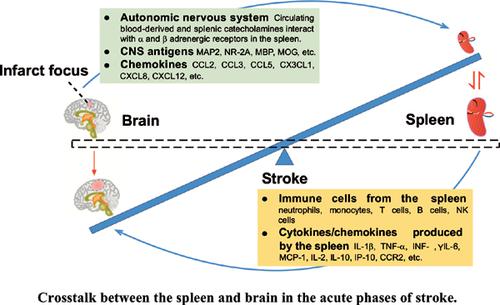Current Neuropharmacology ( IF 5.3 ) Pub Date : 2021-08-31 , DOI: 10.2174/1570159x19666210316092225 Dong Han 1 , Hang Liu 1 , Yan Gao 1 , Juan Feng 1

|
The immune response following acute stroke has received significant attention. The spleen is an important immune organ, and more and more studies have shown that brain-spleen crosstalk after stroke plays an important role in its development and prognosis. There are many mechanisms of spleen activation after stroke, including activation of the sympathetic nervous system, the production of chemokines, and antigen presentation in the damaged brain. The changes in the spleen after stroke are mainly reflected in morphology, changes to immune cells, and cytokine production. Once activated, the spleen contracts, undergoes cellular changes, and releases inflammatory cytokines. Some studies have also shown that spleen cells specifically migrate to the site of primary brain injury. The size of the spleen is also negatively correlated with infarct volume — the more serious the spleen atrophy, the larger the infarct volume. Therefore, a comprehensive understanding of the dynamic response of the spleen to stroke will not only enable understanding of the evolution of ischemic brain injury but will also enable the identification of potential targets for stroke treatment. Here, we review recent basic and clinical drug studies on the spleen as a target for the treatment of stroke, focusing on therapeutic strategies for regulating the splenic response and inhibiting secondary brain injury.
中文翻译:

针对中风后的脑脾串扰:对中风病理学和治疗的新见解
急性中风后的免疫反应受到了极大的关注。脾脏是重要的免疫器官,越来越多的研究表明,脑卒中后脑-脾串扰对其发生发展和预后有重要作用。中风后脾脏激活的机制有很多,包括交感神经系统的激活、趋化因子的产生和受损大脑中的抗原呈递。中风后脾脏的变化主要体现在形态、免疫细胞的变化和细胞因子的产生。一旦被激活,脾脏就会收缩,经历细胞变化,并释放炎性细胞因子。一些研究还表明,脾细胞会特异性迁移到原发性脑损伤部位。脾脏的大小也与梗死体积呈负相关——脾脏萎缩越严重,梗死体积越大。因此,全面了解脾脏对中风的动态反应不仅有助于了解缺血性脑损伤的演变,而且有助于确定中风治疗的潜在靶点。在这里,我们回顾了最近关于脾脏作为治疗中风靶点的基础和临床药物研究,重点关注调节脾脏反应和抑制继发性脑损伤的治疗策略。全面了解脾脏对中风的动态反应不仅有助于了解缺血性脑损伤的演变过程,还有助于确定中风治疗的潜在靶点。在这里,我们回顾了最近关于脾脏作为治疗中风靶点的基础和临床药物研究,重点关注调节脾脏反应和抑制继发性脑损伤的治疗策略。全面了解脾脏对中风的动态反应不仅有助于了解缺血性脑损伤的演变过程,还有助于确定中风治疗的潜在靶点。在这里,我们回顾了最近关于脾脏作为治疗中风靶点的基础和临床药物研究,重点关注调节脾脏反应和抑制继发性脑损伤的治疗策略。



























 京公网安备 11010802027423号
京公网安备 11010802027423号